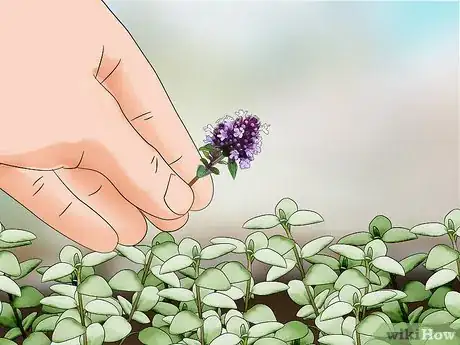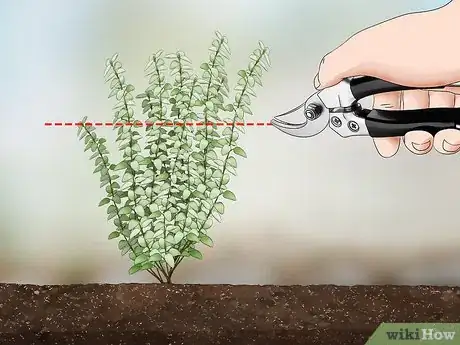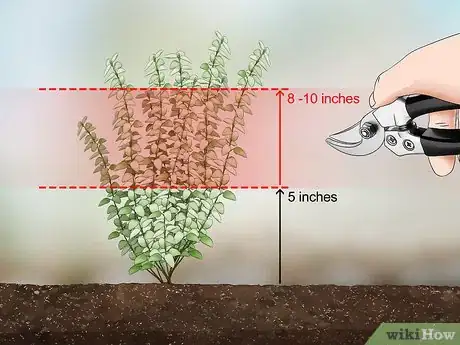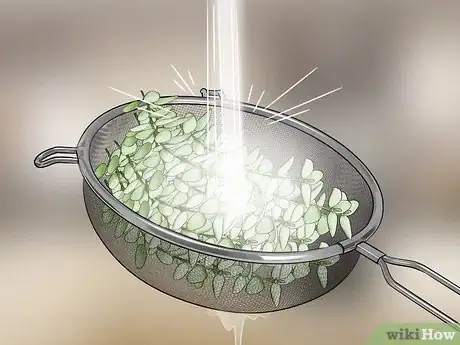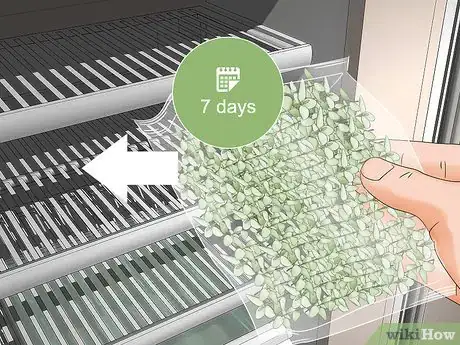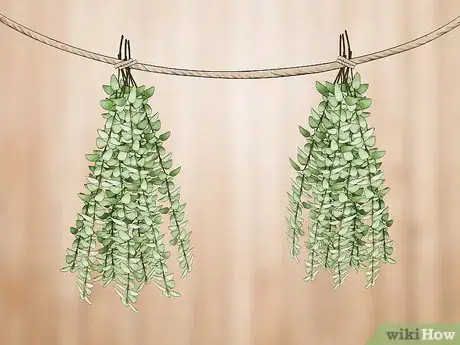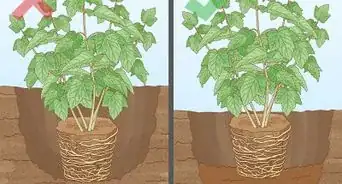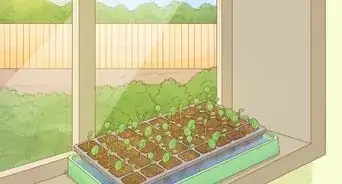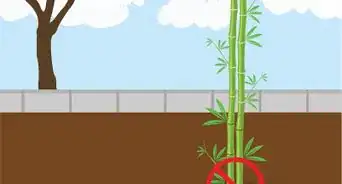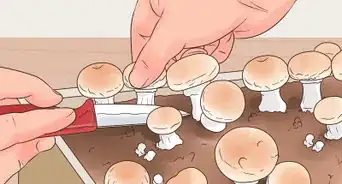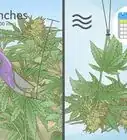This article was co-authored by Lauren Kurtz. Lauren Kurtz is a Naturalist and Horticultural Specialist. Lauren has worked for Aurora, Colorado managing the Water-Wise Garden at Aurora Municipal Center for the Water Conservation Department. She earned a BA in Environmental and Sustainability Studies from Western Michigan University in 2014.
There are 12 references cited in this article, which can be found at the bottom of the page.
wikiHow marks an article as reader-approved once it receives enough positive feedback. In this case, 95% of readers who voted found the article helpful, earning it our reader-approved status.
This article has been viewed 163,816 times.
When growing thyme, you need to regularly prune it throughout the years in order to promote a good shape of the herb and encourage continual growth. Thyme that has become overgrown due to a lack of pruning will be very woody and won’t produce many new stems and leaves. If your thyme has reached this stage, it’s best to replant a new bush and maintain good pruning habits going forward. For regular maintenance, plan to prune the herb in the spring, as desired during the growing season, and in the fall before the first frost.[1]
Steps
Pruning to Promote Healthy Growth
-
1Prune thyme in the early spring once you see new growth starting. Look for the new growth at the base of the plant or from the lower stems.Once you notice new growth, use small garden shears or scissors to trim off about ⅓ of the oldest, woodiest parts of the plant.[2] Do not trim the new growth.
- Trimming more than ⅓ of the plant will leave it too bare and can slow its growth and production, so take care not to cut off too much.[3]
-
2Snip fresh thyme stems throughout the season as needed for cooking. Use small garden shears or scissors to cut off 5 in (13 cm) sprigs to use in recipes. When choosing which stems to cut, try to choose ones that you can leave at least 5 inches (13 cm) of growth behind.
- This regular harvesting is all the pruning that is needed throughout the season. Trimming your thyme regularly will encourage more fresh growth and a more rounded shape.[4]
Advertisement -
3Deadhead the flowers to maintain appearance and encourage regrowth. After the flowers bloom and fade, use scissors or your fingers to remove the dead flowers from the stem. Cut or pinch the stem just below the flower head, but above the first set of healthy leaves.[5]
- Removing dead flowers allows the plant to focus its energy on producing new, healthy stems and growth, and keeps the plant looking alive and fresh.[6]
-
4Cut off the top third of the stems before the first frost to prepare for winter. Do this all-over pruning about 1 month before the first frost is expected to give the plant time to heal and slow its growth before winter.[7] Use small garden shears or scissors to remove only the soft, green stems from the plant. Do not cut past the woody parts of the herb—this is where it the new growth will occur.
- Cutting the thyme way back will allow the herb to better withstand the winter weather and encourages new growth in the following season.
Harvesting Thyme to Use for Cooking
-
1Harvest thyme just before the plant flowers for the best flavor. Once the plant begins to flower, the herb begins to lose some of its flavor and potency. The thyme can still be used after it flowers, just expect a milder flavor.[8]
-
2Cut the thyme when it reaches 8–10 inches (20–25 cm). Use scissors to snip just below the growth node where a new bud or set of leaves is forming. Only remove the fresh, green stems and leave the tough, woody part of the stems behind. Also be sure to leave at least 5 inches (13 cm) of growth so that the plant can continue to thrive.[9]
- Cut the thyme in the morning after the dew has evaporated for the highest concentration of oils.[10]
-
3Wash the thyme in cool water. Hold the thyme under cool running tap water to rinse off dirt and insects. Shake off the excess water and pat the sprigs dry with a clean paper towel.[11]
- Alternatively, you can hose your thyme plant off with a garden hose and allow it to dry for a couple hours before you cut the stems.[12]
-
4
-
5Dry the thyme to preserve it for future use. Dry the thyme in a dehydrator, in the oven, or by hanging it in a warm, dry, dark place. Once the thyme is completely dried out, crumble the sprigs and place them in an airtight jar or container.[15] Store the dried thyme in a cool, dark place for up to 4 years.[16]
- To dry the thyme in a dehydrator, arrange the sprigs in a single layer on the racks in the machine for up to 2 days.[17]
- Dry the thyme in the oven by placing the sprigs on a cookie sheet and baking them with the oven door propped open at 180 °F (82 °C) for 1-2 hours.
- To hang the thyme to dry, bundle about 4-6 sprigs together with twine. Hang the bundles in a warm, dry place out of direct sunlight for about 1 week.[18]
Community Q&A
-
QuestionThree weeks ago I purchased a small thyme perennial. Placed it in direct sun in my house; I also kept it wet and did not allow it to dry out. It has turned completely brown. Can it be saved?
 NinoxTop AnswererIt is not likely. An explanation could be an excess of humidity since the soil was always humid.
NinoxTop AnswererIt is not likely. An explanation could be an excess of humidity since the soil was always humid. -
QuestionI have a plant that is dead with the exception of one sprig. Can I eat the dead thyme that’s dried out around the fresh sprig?
 NinoxTop AnswererYes, you can use it as it were dried thyme. However, the taste can be slightly different.
NinoxTop AnswererYes, you can use it as it were dried thyme. However, the taste can be slightly different. -
QuestionCan I use the thyme flower for new thyme plant?
 NinoxTop AnswererNo, it is difficult to multiply thyme by using the flowers. The best way is to divide the plant in spring.
NinoxTop AnswererNo, it is difficult to multiply thyme by using the flowers. The best way is to divide the plant in spring.
References
- ↑ https://www.theguardian.com/lifeandstyle/2017/jul/22/alys-fowler-prune-woody-herbs-lavendar-thyme-rosemary
- ↑ https://www.gardeningknowhow.com/edible/herbs/thyme/pruning-thyme-plants.htm
- ↑ https://www.diynetwork.com/how-to/outdoors/gardening/how-to-cut-herbs-so-they-keep-growing
- ↑ https://www.thekitchn.com/everything-you-need-to-know-about-growing-thyme-221268
- ↑ https://www.gardeningknowhow.com/ornamental/flowers/fgen/deadheading-flowers.htm
- ↑ https://www.gardeningknowhow.com/ornamental/flowers/fgen/deadheading-flowers.htm
- ↑ http://illinoistimes.com/article-3362-sage-advice-to-cut-thyme.html
- ↑ https://www.thekitchn.com/everything-you-need-to-know-about-growing-thyme-221268
- ↑ https://www.thekitchn.com/everything-you-need-to-know-about-growing-thyme-221268
- ↑ https://www.gardeningknowhow.com/edible/herbs/thyme/harvesting-thyme.htm
- ↑ https://www.gardeningknowhow.com/edible/herbs/thyme/harvesting-thyme.htm
- ↑ https://roundrockgarden.wordpress.com/2009/10/27/how-to-harvest-thyme/
- ↑ https://www.thekitchn.com/4-interesting-ways-to-preserve-fresh-thyme-221269
- ↑ https://www.thekitchn.com/4-interesting-ways-to-preserve-fresh-thyme-221269
- ↑ http://veggieharvest.com/herbs/thyme.html
- ↑ http://www.stilltasty.com/fooditems/index/18501
- ↑ https://www.gardeningknowhow.com/edible/herbs/thyme/harvesting-thyme.htm
- ↑ https://www.gardeningknowhow.com/edible/herbs/hgen/how-to-dry-herbs-various-methods.htm
About This Article
Regularly pruning thyme will help encourage healthy growth and prevent it from becoming too woody. The best time to prune thyme is in early spring once it starts putting out new growth. Use clean garden shears or scissors to cut off ⅓ of the oldest, woodiest growth on the plant. After that, your thyme will be set for the growing season. Just snip off fresh, 5 inch (13 cm) sprigs throughout the season as you need them for cooking. Once the thyme flowers and the blooms fade, pinch them off of the plant to help redirect energy back to stems and leaves. About 1 month before the first frost of winter, prune off the top third of your thyme plant to help prepare it for dormancy over the winter. For more help from our Horticulturist co-author, like how to harvest thyme for cooking, read on!


